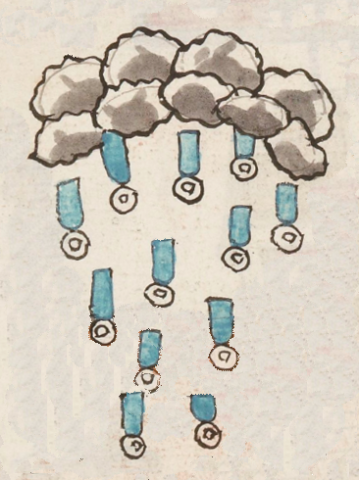quiyahuitl (TR41r)
This example of a simplex glyph from the Codex Telleriano-Remensis shows an arching group of clouds (with dark shading at the bottom, giving them a three-dimensional aspect) and twelve streaming drops of rain coming down from the clouds. The staggering of these raindrops at different heights provides a type of visual movement, as though they are falling through the air. Each stream of turquoise-blue water (with its lines of current, more movement) has a droplet or jade bead at the end. It has been extracted from a toponym, as can be seen in the contextualizing image below.
Stephanie Wood
This example of rain comes from a place name in the Mixteca, a region in the state of Oaxaca. The place is called Tlaxiaco today, but it used to refer to a ball court (tlachtli) and, only literally, to rain (quiyauhuitl), in Nahuatl. Rain is a day name in the 260-day divinatory calendar called the tonalpohualli in Nahuatl, which underlines its religious significance. Rain, of course, is also essential in zones of temporal agriculture, such as this one. But, in the compound from which this element derives, rain appears to have been playing a phonetic role for -quiyahuac (outside or at the entrance--to the ball court).
Stephanie Wood
tlchquiaco
Tlachquiyauhco (today: Tlaxiaco, Oaxaca)
Stephanie Wood
ca. 1550–1563
Jeff Haskett-Wood
rain, lluvia, nubes, clouds, entrada, ballcourt, ball court, canchas

quiyahui(tl), rain, https://nahuatl.wired-humanities.org/content/quiyahuitl
la lluvia
Stephanie Wood
Telleriano-Remensis Codex, folio 41 recto, MS Mexicain 385, Gallica digital collection, https://gallica.bnf.fr/ark:/12148/btv1b8458267s/f107.item.zoom
The non-commercial reuse of images from the Bibliothèque nationale de France is free as long as the user is in compliance with the legislation in force and provides the citation: “Source gallica.bnf.fr / Bibliothèque nationale de France” or “Source gallica.bnf.fr / BnF.”



